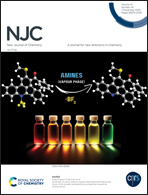Photocatalytic hydrogen production by donor–π–acceptor type covalent triazine frameworks involving different π bridges†
Abstract
Covalent triazine frameworks (CTFs) involving donor-π bridge-acceptor (D–π–A) motifs with the electron-withdrawing triazine unit as the acceptor have been regarded as one of the most promising materials for photocatalytic water splitting. The intrinsic features of π-bridges play a critical role in tailoring the polymer properties as well as the photocatalytic performance. Introducing suitable conjugated units as the π-bridge is expected to effectively tune the electronic structure of the resultant D–π–A CTFs and facilitate photo-generated charge separation. However, systematic studies on how different π-bridges would influence the photoelectronic properties of D–π–A type CTFs are still limited. Herein, three types of CTFs with well-defined D–π–A structures named Ben-CTF, BenT-CTF and BenP-CTF were synthesized to investigate the effects of different π-bridges (benzene, thiophene and pyridine units) on the performance of photocatalytic water splitting for hydrogen production. Comprehensive experiments and density functional theory (DFT) calculations revealed that BenP-CTF with the pyridine unit as the π-bridge exhibited superior charge migration ability and higher photocatalytic hydrogen evolution reaction (HER) rates compared to the other CTFs. This work may provide a reference for the rational design and controllable synthesis of CTF materials for efficient photocatalysis.



 Please wait while we load your content...
Please wait while we load your content...